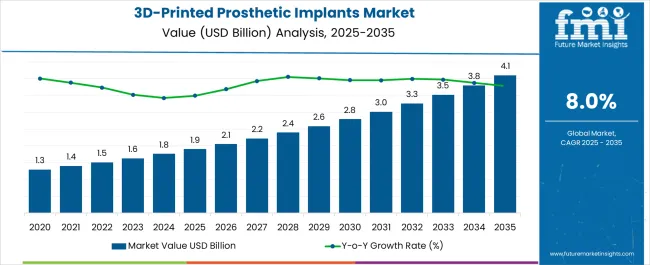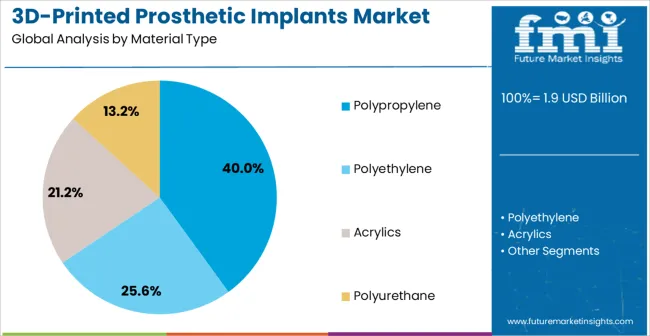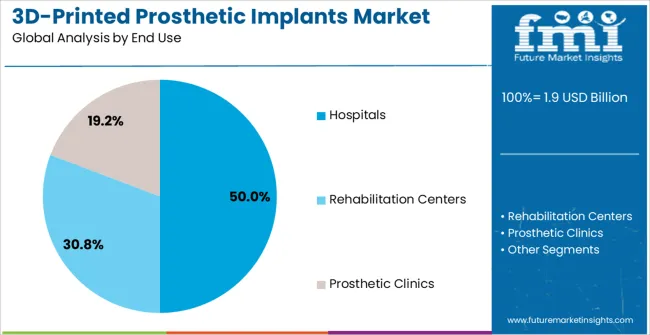The 3D-Printed Prosthetic Implants Market is estimated to be valued at USD 1.9 billion in 2025 and is projected to reach USD 4.1 billion by 2035, registering a compound annual growth rate (CAGR) of 8.0% over the forecast period.

| Metric | Value |
|---|---|
| 3D-Printed Prosthetic Implants Market Estimated Value in (2025 E) | USD 1.9 billion |
| 3D-Printed Prosthetic Implants Market Forecast Value in (2035 F) | USD 4.1 billion |
| Forecast CAGR (2025 to 2035) | 8.0% |
The 3D-Printed Prosthetic Implants market is witnessing substantial growth due to advancements in additive manufacturing technologies that enable precise, patient-specific implants. Current market trends indicate a rising preference for customized solutions in orthopedic and craniofacial surgery, driven by the demand for reduced recovery times and improved surgical outcomes. The market is being propelled by increased healthcare infrastructure investments, adoption of digital healthcare solutions, and growing awareness of patient-specific treatment benefits.
Cost efficiency and reduced material wastage offered by 3D printing are enhancing its appeal to both healthcare providers and patients. In addition, regulatory frameworks are increasingly supporting the use of biocompatible 3D-printed materials, which allows for wider adoption in hospitals and clinics.
The integration of advanced imaging techniques with additive manufacturing ensures accurate prosthetic design, improving patient satisfaction and clinical outcomes Over the next decade, the market is expected to expand further as surgeons and medical facilities increasingly leverage technology-driven prosthetic implants for complex reconstructions and personalized patient care.
The 3d-printed prosthetic implants market is segmented by material type, end use, and geographic regions. By material type, 3d-printed prosthetic implants market is divided into Polypropylene, Polyethylene, Acrylics, and Polyurethane. In terms of end use, 3d-printed prosthetic implants market is classified into Hospitals, Rehabilitation Centers, and Prosthetic Clinics. Regionally, the 3d-printed prosthetic implants industry is classified into North America, Latin America, Western Europe, Eastern Europe, Balkan & Baltic Countries, Russia & Belarus, Central Asia, East Asia, South Asia & Pacific, and the Middle East & Africa.

The Polypropylene material type is projected to hold 40.00% of the 3D-Printed Prosthetic Implants market revenue share in 2025, making it the leading material segment. This dominance is being driven by polypropylene’s favorable combination of lightweight properties, biocompatibility, and mechanical strength, which are essential for durable and patient-specific prosthetic implants. Adoption has been reinforced by the material’s flexibility in complex geometries, allowing intricate designs without compromising structural integrity.
Polypropylene’s resistance to chemical degradation and ease of sterilization further supports its suitability for surgical applications. Additionally, the ability to rapidly prototype and produce implants with polypropylene reduces overall manufacturing time and enhances operational efficiency for medical facilities.
Hospitals benefit from lower material costs, minimal waste, and the adaptability of polypropylene to integrate with other biomaterials for hybrid implants As 3D printing technology continues to evolve, polypropylene is expected to remain a preferred material due to its scalability, performance reliability, and alignment with the growing demand for personalized prosthetic solutions.

The Hospitals end-use segment is anticipated to account for 50.00% of the 3D-Printed Prosthetic Implants market revenue in 2025, establishing it as the dominant application segment. This leadership is being attributed to hospitals’ increasing reliance on advanced surgical procedures that demand patient-specific implants to improve clinical outcomes. The segment’s growth has been supported by the integration of 3D printing technologies with preoperative imaging and planning tools, allowing precise and efficient production of prosthetic implants.
Hospitals benefit from reduced surgery times, lower postoperative complications, and improved patient satisfaction through customized implants. The expansion of orthopedic and reconstructive surgery programs, combined with investments in specialized 3D printing labs within hospital settings, has further accelerated adoption.
In addition, hospitals are leveraging these technologies to streamline inventory management by producing implants on-demand, reducing storage requirements and associated costs As the emphasis on personalized patient care and surgical efficiency continues to rise, hospitals are expected to maintain their position as the largest end-use segment in the market, driving sustained growth of 3D-printed prosthetic implants.
3D-printed prosthetic implants are the identical body part which are designed using 3D printed technology. 3D scanning and printing is latest sci-fi technology which is used in various medical application such as designing the 3D-printed prosthetic implants. 3-D scanner used for designing the 3D-printed prosthetic implants provide three dimensional data quickly and accurately.
Along with 3-D scanner, 3D custom-made medical devices are used to create anatomical model of 3D-printed prosthetic implants. 3-D printed technology also allow to design the 3D-printed prosthetic implants that fits to the anatomy of each patients.
But, the 3D-printed prosthetic implants are well suited for specific diseases and pathologies. Also, the use of 3D-printed prosthetic implants have high rate of complications. The major application of 3D-printed prosthetic implants replace the damaged human body part, but nowadays 3D-printed prosthetic implants are also used for the treatment of hearing loss.

| Country | CAGR |
|---|---|
| China | 10.8% |
| India | 10.0% |
| Germany | 9.2% |
| Brazil | 8.4% |
| USA | 7.6% |
| UK | 6.8% |
| Japan | 6.0% |
The 3D-Printed Prosthetic Implants Market is expected to register a CAGR of 8.0% during the forecast period, exhibiting varied country level momentum. China leads with the highest CAGR of 10.8%, followed by India at 10.0%. Developed markets such as Germany, France, and the UK continue to expand steadily, while the USA is likely to grow at consistent rates. Japan posts the lowest CAGR at 6.0%, yet still underscores a broadly positive trajectory for the global 3D-Printed Prosthetic Implants Market.
In 2024, Germany held a dominant revenue in the Western Europe market and is expected to grow with a CAGR of 9.2%. The USA 3D-Printed Prosthetic Implants Market is estimated to be valued at USD 676.2 million in 2025 and is anticipated to reach a valuation of USD 676.2 million by 2035. Sales are projected to rise at a CAGR of 0.0% over the forecast period between 2025 and 2035. While Japan and South Korea markets are estimated to be valued at USD 95.3 million and USD 60.2 million respectively in 2025.

| Item | Value |
|---|---|
| Quantitative Units | USD 1.9 Billion |
| Material Type | Polypropylene, Polyethylene, Acrylics, and Polyurethane |
| End Use | Hospitals, Rehabilitation Centers, and Prosthetic Clinics |
| Regions Covered | North America, Europe, Asia-Pacific, Latin America, Middle East & Africa |
| Country Covered | United States, Canada, Germany, France, United Kingdom, China, Japan, India, Brazil, South Africa |
| Key Companies Profiled | 3D Systems Corporation, EnvisionTEC GmbH, Stratasys Ltd., Bionicohand, YouBionic, UNYQ, Mecuris, and LimbForge, Inc. |
The global 3D-Printed prosthetic implants market is estimated to be valued at USD 1.9 billion in 2025.
The market size for the 3D-Printed prosthetic implants market is projected to reach USD 4.1 billion by 2035.
The 3D-Printed prosthetic implants market is expected to grow at a 8.0% CAGR between 2025 and 2035.
The key product types in 3D-Printed prosthetic implants market are polypropylene, polyethylene, acrylics and polyurethane.
In terms of end use, hospitals segment to command 50.0% share in the 3D-Printed prosthetic implants market in 2025.






Our Research Products

The "Full Research Suite" delivers actionable market intel, deep dives on markets or technologies, so clients act faster, cut risk, and unlock growth.

The Leaderboard benchmarks and ranks top vendors, classifying them as Established Leaders, Leading Challengers, or Disruptors & Challengers.

Locates where complements amplify value and substitutes erode it, forecasting net impact by horizon

We deliver granular, decision-grade intel: market sizing, 5-year forecasts, pricing, adoption, usage, revenue, and operational KPIs—plus competitor tracking, regulation, and value chains—across 60 countries broadly.

Spot the shifts before they hit your P&L. We track inflection points, adoption curves, pricing moves, and ecosystem plays to show where demand is heading, why it is changing, and what to do next across high-growth markets and disruptive tech

Real-time reads of user behavior. We track shifting priorities, perceptions of today’s and next-gen services, and provider experience, then pace how fast tech moves from trial to adoption, blending buyer, consumer, and channel inputs with social signals (#WhySwitch, #UX).

Partner with our analyst team to build a custom report designed around your business priorities. From analysing market trends to assessing competitors or crafting bespoke datasets, we tailor insights to your needs.
Supplier Intelligence
Discovery & Profiling
Capacity & Footprint
Performance & Risk
Compliance & Governance
Commercial Readiness
Who Supplies Whom
Scorecards & Shortlists
Playbooks & Docs
Category Intelligence
Definition & Scope
Demand & Use Cases
Cost Drivers
Market Structure
Supply Chain Map
Trade & Policy
Operating Norms
Deliverables
Buyer Intelligence
Account Basics
Spend & Scope
Procurement Model
Vendor Requirements
Terms & Policies
Entry Strategy
Pain Points & Triggers
Outputs
Pricing Analysis
Benchmarks
Trends
Should-Cost
Indexation
Landed Cost
Commercial Terms
Deliverables
Brand Analysis
Positioning & Value Prop
Share & Presence
Customer Evidence
Go-to-Market
Digital & Reputation
Compliance & Trust
KPIs & Gaps
Outputs
Full Research Suite comprises of:
Market outlook & trends analysis
Interviews & case studies
Strategic recommendations
Vendor profiles & capabilities analysis
5-year forecasts
8 regions and 60+ country-level data splits
Market segment data splits
12 months of continuous data updates
DELIVERED AS:
PDF EXCEL ONLINE
Prosthetics and Orthotics Market - Growth & Future Trends 2025 to 2035
Prosthetic Heart Valve Market is segmented by product & end user from 2025 to 2035
Bio-Implants Market Analysis - Size, Share, and Forecast Outlook for 2025 to 2035
Gel Implants Market Analysis - Trends, Share & Forecast 2025 to 2035
Competitive Overview of Neuroprosthetics Companies
Smart Implants Market Size and Share Forecast Outlook 2025 to 2035
Brain Implants Market Size and Share Forecast Outlook 2025 to 2035
Cheek Implants Market
Spinal Implants and Devices Market Size and Share Forecast Outlook 2025 to 2035
Industry Share & Competitive Positioning in Breast Implants Market
Ocular Implants Market
Facial Implants Market
Struts Implants Market
Medical Implants Precision Machining Service Market Size and Share Forecast Outlook 2025 to 2035
Steroid Implants Market Analysis - Size, Share, and Forecast Outlook 2025 to 2035
Humeral Implants Market Growth – Trends & Forecast 2025 to 2035
Passive Prosthetics Market
Aniridia Implants Market Size and Share Forecast Outlook 2025 to 2035
Cosmetic Implants Market Size and Share Forecast Outlook 2025 to 2035
Cervical Implants Market

Thank you!
You will receive an email from our Business Development Manager. Please be sure to check your SPAM/JUNK folder too.
Chat With
MaRIA